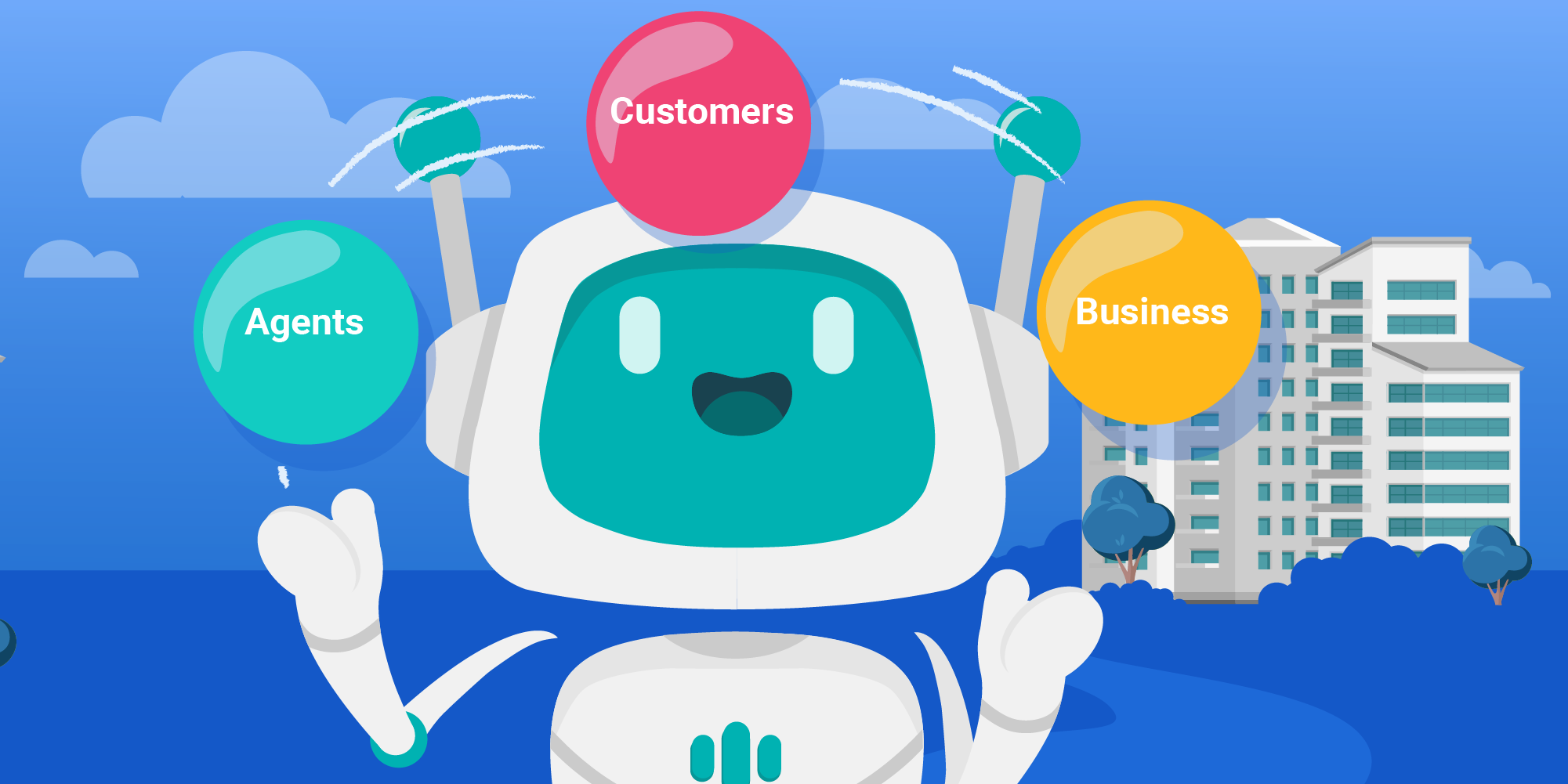Workforce management (WFM) is about more than forecasting and scheduling agents. It’s about juggling the interests of three important stakeholders: your business, employees, and customers. Striking a balance among them is no easy feat. What happens when there’s an imbalance? Here are three problematic scenarios and what you, the WFM professional, can do to restore harmony.
Scenario 1: Business interests are your priority
Maximizing profit wherever possible is a strong interest within any business. As a workforce manager, it’s your job to ensure business efficiency. After all, “scheduling agents” is another term for allocating resources. Having efficient schedules does increase profit. That’s why it’s easy to get carried away when increasing efficiency in your contact center.
Here’s a common scenario: You start cutting costs by using every available agent in the most efficient way to meet your service level. You strive to maximize the output of your limited agents. You cut non-essentials like meetings, coaching, and training sessions. But, now, as a result of your changes, your agents are unhappy. Your top performers have started complaining.
Your focus on business efficiency may have produced some of the following problems:
- Some agents are stuck working the same bad shifts every week to meet your coverage.
- You are changing your agents’ schedules frequently.
- You are not accommodating your agents’ preferences and disturbing their work-life balance.
- There are no breaks between calls for your agents to catch their breaths.
- Agents are not getting the support they need to do their work effectively.
While the intention was to increase efficiency, the long-term impact of this scenario can quickly reduce the profits gained. The initial symptoms of a problem may present themselves as lower agent satisfaction and absenteeism. As time goes on, you’ll start to see:
- Higher agent attrition rates. Unhappy agents will eventually leave for external opportunities. This can really hurt your bottom line, especially if your high performing agents exit. According to McKinsey & Company, the average cost of a new agent hire is $10,000-$20,000. This includes hiring, training, and lost productivity.
- Lower customer satisfaction metrics. Unhappy agents lead to unhappy customers. When agents get no downtime between customers, they do not have time to recover from challenging situations. Without the ongoing training and mentorship opportunities, your agents will be less equipped to handle normal customer interactions, as well.
- Not meeting service level. As high performers leave, you’ll have fewer well-trained agents doing the work. This results in employee burn-out. It also results in an inability to achieve your service level goals.
Before you have these issues ruin your hard work, here are some tips for keeping your business interests in check:
- Survey your agents. Get ahead of potential scheduling issues by soliciting direct feedback from agents. You can send out an employee net promoter score (eNPS) survey weekly or monthly. This will help you uncover any unintended consequences before they become bigger problems. Also, consider soliciting this feedback anonymously, so agents don’t have to fear personal repercussions.
- Create a threshold for your occupancy rate. For inbound calls, the threshold should be 90% or lower. If you notice occupancy creep up past this target, you may plan to address this in your scheduling. You can learn about how to manage occupancy here.
- Factor in shrinkage. Instead of eliminating agent development opportunities, factor them in. Calculate your shrinkage, so you can plan for it effectively. If you're worried about absenteeism, check in on this after you’ve made abrupt scheduling changes. You can find more about how to include shrinkage in your planning here.
- Keep an eye on your customer satisfaction metrics. While you may be meeting your service level, you will still need to determine if the quality of our customer interactions is still high. You can do this by checking your customer satisfaction (CSAT) scores. Lower scores could be a result of unhappy or disengaged agents.
- Talk with your contact center leaders about a realistic budget. You may feel like having to squeeze out every drop of efficiency from your agents because your budget is tight. Create a proposal to raise the budget to prevent agent burn-out and to properly factor in coaching and training.
Scenario 2: Employees are #1
Valuing your employees is great for your business. The happiness of your agents improves the quality of your customer interactions. Giving agents the time and resources for development is a good investment, too. However, there are drawbacks to granting your agents all of their scheduling wishes.
Here’s a typical scenario: Employees get treated really well in your contact center. Your agents have a great work-life balance. Either they have fixed 8-to-5 schedules or flexible schedules that meet all their needs. These agents may also have access to development activities to improve their skills. But, it’s hard for you to achieve your service level.
In this situation, employees’ interests are prioritized above all others. This may result in the following problems:
- Your service level is consistently below target.
- Your business loses revenue as more and more dissatisfied customers leave.
- Breaks, lunches, meetings, coaching and training are contributing to poor coverage; they are scheduled without keeping fluctuating staffing requirements in mind.
To improve this situation, you’ll have to understand the full extent of your problem. You may want to start by evaluating the following metrics:
- Average speed of answer (ASA). If your average speed of answer is too high, this contributes to underperforming on service level. There are plenty of reasons that can lead to high ASA. The most obvious is that your plan simply doesn’t match the reality. If your contact center is staffed with 20 agents, but in reality, 30 would be needed to cover demand, your ASA will spike. Agents can also drive up ASA. Investigate your ASA metric and how it impacts your service level.
- Schedule adherence. Determine if adherence is being disobeyed. If it is, you may have to dig deeper to determine if this is due to longer handle times that are unplanned or to agent behavior. Lack of adherence will directly lead to a higher ASA. Instead of micromanaging adherence in real-time, review it for each agent the next day. Provide agents and supervisors with adherence reports, so they can improve this metric.
- Shrinkage. Breaks and unproductive activities can hurt your coverage. To adequately measure their effects, you may need to create groupings for various shrinkage activities. The main issue you’ll want to resolve is to create realistic shrinkage numbers. Then, you can include them in your planning. You can optimize the timing of shrinkage activities. Your contact center may also want to resolve the shrinkage issue by increasing staffing, but your first step should be to improve planning.
Scenario 3: The customer always comes first
Customers are essential to your business. They are the reason you have a contact center and a job in the first place. Customers are not only your source of revenue, but they can be an extension of your marketing team. When they have great experiences, customers spread the word about your brand. This can lead to future revenue.
While it’s important to keep your customers top-of-mind in all of your efforts, you should be wary of the following scenario:
You always have more agents on a shift than needed. For most shifts, agents are exceeding your customer demand. Agents are competing with each other on answering customer calls. Your customers are answered with such speed you don’t even have to look at ASA or your service level. Your CSATs are through the roof. Success? Well, not exactly. You’ve overstaffed and may have neglected your business efficiency.
Your contact center may be consistently meeting service level, but long-term overstaffing can have the following consequences:
- Your contact center will lose a lot of money.
- Agents get bored and become unengaged.
- Over time, your service level and customer quality metrics will dip along with your agents’ productivity.
When your margins are slim, overstaffing can be a nightmare. To prevent long-term losses, here are some ideas that will get you back on track:
- Improve forecasting. This scenario is a classic case of your forecast not being accurate. If you’re consistently overstaffing, review your forecasting fundamentals to figure out the root cause for the problem.
- Creative scheduling. If all of your employees have fixed schedules, then this is definitely a problem for you. Flexible scheduling is key to meet the fluctuating call volumes of your center. Start by reviewing agent contracts. Maybe, you can create scenarios where some of your workers are working part-time or on flexible schedules. Learn more about typical scheduling mistakes to avoid here.
- Measure your schedule efficiency. Have you measured how good your schedules are? Instead of eye-balling graphs of your supply-demand curves, you need to quantify your efficiency and set up an efficiency threshold. This efficiency threshold will be a percentage of overstaffing you can afford like 10% of your requirement per interval. Learn more about how to measure your schedule efficiency here.
Finding workforce management harmony
Workforce management is often oversimplified to the tasks of planning agents’ schedules. But it is so much more than this. In your work, you are struggling to maintain an equilibrium among your contact center’s key stakeholders.
Finding harmony with customers, agents, and business players may need a strategic approach. You are not the only one responsible for your contact center’s success. Yet you have an essential role. As a WFM professional, you provide valuable insights to inform strategic decisions. You also play an important part in delivering solutions to keep your contact center in balance.
Did you find the article interesting and would like to share it with your colleagues? Download the article as a PDF.





